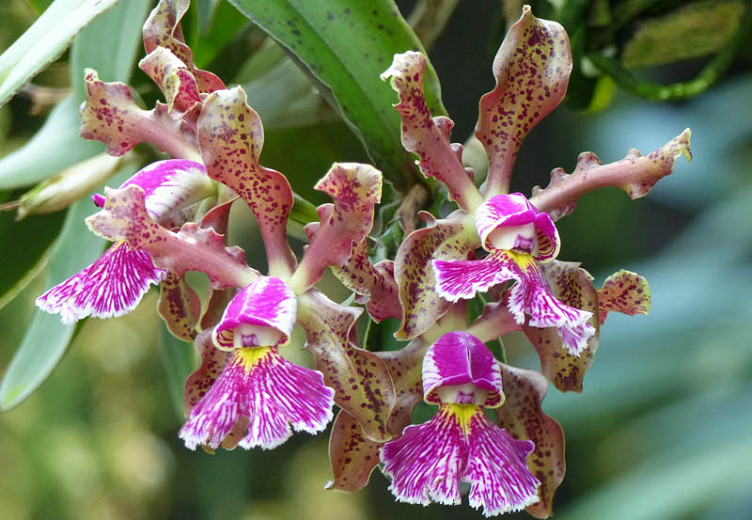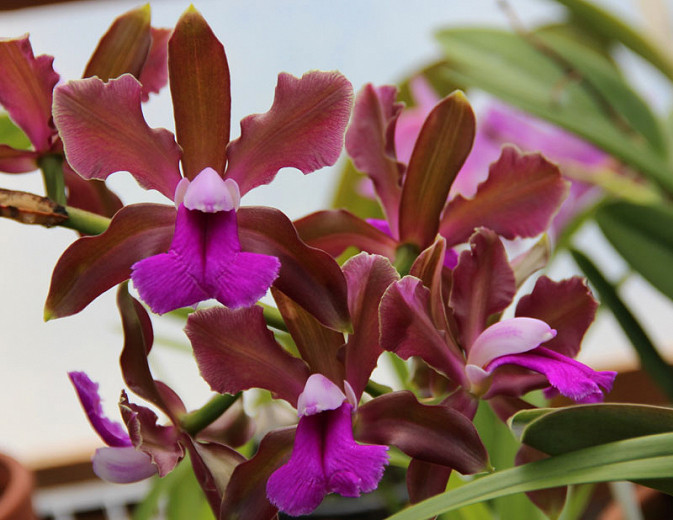Cattleya schilleriana (Consul Schillers Cattleya)
Cattleya schilleriana (Consul Schiller's Cattleya) is a small-sized, epiphytic, or lithophytic orchid boasting 1-5 inflorescences giving rise to highly fragrant, long-lived flowers. Blooming in the spring and early summer, occasionally in summer and the fall, the blossoms, 4 in. across (10 cm), are wonderfully fragrant, waxy, and have a high sheen. Lasting for about 3-4 weeks, they feature tan, brown, and mahogany sepals and petals, overlaid with darker spots, and a striking white lip with rich magenta striations. The club-shaped pseudobulbs carry 2 elliptic-oblong, spreading, deep green leaves above, reddish-purple below, about 4 in. long (10 cm). Native to Brazil, Cattleya schilleriana is a cool to hot growing orchid species found in coastal eastern Brazil at elevations of 650-2600 ft. (200-800 m).
- Grows up to 10 in. tall (25 cm).
- Can be grown either in pots or bare-rooted on a raft in bright light to some sun, with no direct sun in the middle of the day. Provide good ventilation.
- Needs a minimum night temperature of 62-68°F (17-20°C) and a daytime temperature of 68-82°F (20-28°C) during its active growth period. When the plant is resting, temperatures are 64-66°F (18-19°C) during the day and 53-55°F (12-13°C) at night.
- Maintain adequate humidity (50-60%) throughout the year by setting the plant on a tray of gravel, partially filled with water, so that the pot never sits in the water.
- Water when the substrate gets almost dry during its active growth period. During rest, the substrate must remain completely dry for 5 days between watering. Rest ends with the arrival of new growths from the base of the pseudobulbs.
- During the growing season, feed every 3 watering with 1/2 of the dose indicated on the bottle of a special liquid fertilizer for orchids.
- Propagate by division when the plant overflows the pot.
- Once the flowers have faded, remove the spent flower spikes.
- Potting is necessary when the rhizome of the plant protrudes over the edge of the pot or the potting medium starts to break down. It is best to repot just before new roots sprout from the rhizome, after flowering, or in the spring.
- Generally disease free. Keep an eye out for aphids, glasshouse red spider mites, and mealybugs.
- Native to Brazil.
Tip for reblooming
- If the flower sheath forming at the base of the leaf (where the new flower spike will emerge) becomes yellow before the new flower spike forms, this could indicate bud or sheath blasting. A fast temperature change outside the sheath may have caused condensation to form within the sheath, where it will rot the newly forming flower spike. To resolve this, carefully tear or cut the sheath away without damaging the flower buds and spike within.
Requirements
| Hardiness | 10 – 13 |
|---|---|
| Plant Type | Orchids |
| Plant Family | Cattleya – Orchids |
| Exposure | Partial Sun |
| Season of Interest | Spring (Early,Mid,Late)Summer (Early,Mid,Late)Fall |
| Height | 10" – 1' (25cm – 30cm) |
| Water Needs | Average |
| Maintenance | Average |
| Soil Drainage | Well-Drained |
| Characteristics | Cut Flowers, Fragrant, Showy, Evergreen |
| Garden Uses | Patio and Containers |


